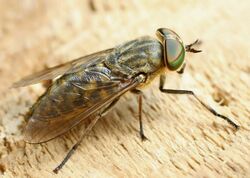Biology:Tabanus bromius
| Tabanus bromius | |
|---|---|

| |
| Tabanus bromius female | |
| Scientific classification | |
| Domain: | Eukaryota |
| Kingdom: | Animalia |
| Phylum: | Arthropoda |
| Class: | Insecta |
| Order: | Diptera |
| Family: | Tabanidae |
| Subfamily: | Tabaninae |
| Tribe: | Tabanini |
| Genus: | Tabanus |
| Species: | T. bromius
|
| Binomial name | |
| Tabanus bromius | |
| Synonyms | |
| |
Tabanus bromius, sometimes called the band-eyed brown horsefly, is a species of biting horseflies.[9]
Description
Tabanus bromius is one of the smaller European Tabanus, at about 13.5–15 millimetres (0.5–0.6 in) body length.[10]
The mesonotum is grayish and bears on the top five indistinct longitudinal lines, while the abdomen is black, hairy and carries three rows of yellowish spots. The ventral side of the abdomen is light gray. The head is silver-gray and the compound eyes are green, with a violet-red transversal band. The wings are transparent, have brown veins and a length of 10.5–11 millimetres (0.41–0.43 in).
The females of these flies are bloodsuckers, feeding on mammalian blood, mainly cattle and horses, but they can also bite humans. The males feed on nectar, especially on Angelica sylvestris. The activity of these horseflies takes place in plain daylight, preferably in hot and muggy days and in the absence of wind. They are particularly aggressive during the full and late summer and bites cause painful welts.
The adult horsefly flies from late May until early September.
Distribution
This species is widespread in most of Europe, in the eastern Palearctic realm, in North Africa, and in the Near East.
Habitat
These horseflies prefer open spaces, such as hills or sparsely wooded areas.
References
- ↑ Linnaeus, C. (1758). Systema naturae... Ed. 10, Vol. 1. Holmiae [= Stockholm]: L. Salvii. pp. 824 pp. https://www.biodiversitylibrary.org/item/10277#page/2/mode/1up. Retrieved 14 November 2022.
- ↑ Loew, H. (1858). "Zur Kenntniss der europäische n Tabanus-Arten". Verhandlungen der Zoologisch-Botanischen Gesellschaft in Wien 8 (Abhandl.): 573–612. https://www.zobodat.at/pdf/VZBG_8_0573-0612.pdf. Retrieved 12 October 2022.
- ↑ Gimmerthal, B.A. (1847). "Dritter Beitrag zu einer kunftig zu bearbeitenden Dipterologie Russlands". Bull. Soc. Nat. Moscou 20 (1): 175-223.
- ↑ Walker, F. (1856). nsecta Britannica, Diptera. 3. London: L. Reeve. pp. xxiv + 352 pp., pls. 21-30.
- ↑ Schiner, Ignaz Rudolph (1860). "Fauna Austriaca". Theil I. Heft (3/4): 185-368.
- ↑ 6.0 6.1 Meigen, J.W. (1820). Systematische Beschreibung der bekannten europäische n zweiflugeligen Insekten. Aachen: Zweiter Theil. Forstmann. pp. xxxvi + 363. https://www.biodiversitylibrary.org/item/45915#page/9/mode/1up. Retrieved 8 July 2022.
- ↑ De Geer, C. (1776). Memoires pour servir a l'histoire des insectes. Stockholm: P. Hesselberg. pp. viii + 523 pp., 30 pls.
- ↑ Szilády, Zoltán (1914). "Neue oder wenig bekannte paläarktische Tabaniden". Annales Historico-Naturales Musei Nationalis Hungarici 12: 661-673. https://www.biodiversitylibrary.org/item/254702#page/677/mode/1up. Retrieved 18 October 2022.
- ↑ Chvála, Milan; Lyneborg, Leif; Moucha, Josef (1972). The Horse Flies of Europe (Diptera, Tabanidae). Copenhagen: Entomological Society of Copenhagen. pp. 598pp, 164figs. ISBN 978-09-00-84857-5.
- ↑ Stubbs, A.; Drake, M. (2001). British Soldierflies and Their Allies: A Field Guide to the Larger British Brachycera. British Entomological & Natural History Society. pp. 512 pp. ISBN 1-899935-04-5.
External links
Wikidata ☰ Q1500723 entry
 |


